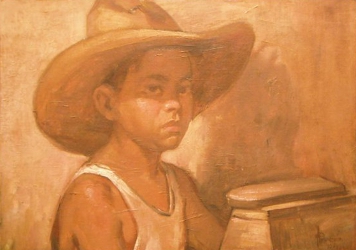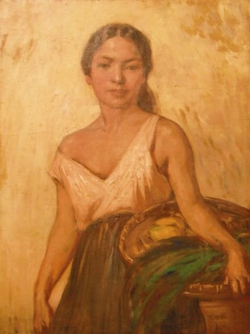Pablo Amorsolo on:
[Wikipedia]
[Google]
[Amazon]
Pablo Cueto Amorsolo (born Pablo Amorsolo y Cueto; June 26, 1898 – February 21, 1945) was a
retrieved on March 18, 2008An article about Fernando C. Amorsolo that mentions Pablo Amorsolo, Cultural Heritage, GlobalPinoy.com, 2006
, retrieved on: April 6, 2008Guillermo, Alice G. "Pablo Amorsolo" (as instructor at the University of the Philippines), Encyclopedia of Philippine Art. Manila: Cultural Center of the Philippines, 1994.

/ref> *''The Discovery of the Philippines'', 1945
Osias, Camilo, Fernando and Pablo Amorsolo (illustrators), The Philippine Readers Series (exhibition), volumes of basic instructional materials during the American period, 15 September – 12 November 2006, The Landing Gallery, UP Jorge B. Vargas Museum, Diliman, Quezon City
an
UP Vargas Museum
Pablo Cueto Amorsolo
{{DEFAULTSORT:Amorsolo, Pablo Filipino portrait painters University of the Philippines alumni 1898 births Bicolano people 1945 deaths People from Camarines Norte 20th-century Filipino painters People executed by firing squad Executed Filipino people
Filipino
Filipino may refer to:
* Something from or related to the Philippines
** Filipino language, standardized variety of 'Tagalog', the national language and one of the official languages of the Philippines.
** Filipinos, people who are citizens of th ...
painter
Painting is the practice of applying paint, pigment, color or other medium to a solid surface (called the "matrix" or "support"). The medium is commonly applied to the base with a brush, but other implements, such as knives, sponges, and ai ...
. He was the younger brother of the Philippine National Artist
The Order of National Artists of the Philippines ( Filipino: ''Orden ng mga Pambansang Alagad ng Sining ng Pilipinas'') is an order bestowed by the Philippines on Filipinos who have made significant contributions to the development of Philipp ...
Fernando Amorsolo
Fernando Cueto Amorsolo (born Fernando Amorsolo y Cueto; May 30, 1892 – April 24, 1972) was a portraitist and painter of rural Philippine landscapes. Nicknamed the "Grand Old Man of Philippine Art," he was the first-ever to be recognized as a N ...
.”Pablo Cueto Amorsolo,” GeringerArt.com (undated)retrieved on March 18, 2008An article about Fernando C. Amorsolo that mentions Pablo Amorsolo, Cultural Heritage, GlobalPinoy.com, 2006
, retrieved on: April 6, 2008Guillermo, Alice G. "Pablo Amorsolo" (as instructor at the University of the Philippines), Encyclopedia of Philippine Art. Manila: Cultural Center of the Philippines, 1994.


Biography
Pablo Amorsolo y Cueto was born inDaet, Camarines Norte
Daet (), officially the Municipality of Daet ( bcl, Banwaan kan Daet; tl, Bayan ng Daet), is a 1st class municipality and capital of the province of Camarines Norte, Philippines. According to the 2020 census, it has a population of 111,700 peo ...
to husband and wife Pedro Amorsolo, a book keeper, and Bonifacia Cueto y Vélez. When he was eight years old, his family moved to Manila
Manila ( , ; fil, Maynila, ), officially the City of Manila ( fil, Lungsod ng Maynila, ), is the capital of the Philippines, and its second-most populous city. It is highly urbanized and, as of 2019, was the world's most densely populate ...
.
During World War II, Amorsolo engaged in partisan activities under the Japanese regime and was said to have gained the rank of Colonel under the Kempeitai. Eventually he was captured by Filipino
Filipino may refer to:
* Something from or related to the Philippines
** Filipino language, standardized variety of 'Tagalog', the national language and one of the official languages of the Philippines.
** Filipinos, people who are citizens of th ...
troops.
He was sentenced and executed by firing squad in the hands of guerillas
Guerrilla warfare is a form of irregular warfare in which small groups of combatants, such as paramilitary personnel, armed civilians, or irregulars, use military tactics including ambushes, sabotage, raids, petty warfare, hit-and-run tactic ...
. He died in this manner at Antipolo, Rizal in 1945.
Education
He became an apprentice-painter under the guidance of his uncle,Fabián de la Rosa
Don Fabián de la Rosa y Cueto (May 5, 1869 – December 14, 1937) was a Filipino painter. He was the uncle and mentor to the Philippines' national artist in painting, Fernando Amorsolo, and to his brother Pablo. He is regarded as a "master of ge ...
, an expert painter. After elementary schooling, Amorsolo studied at the Lyceum of Manila. He later graduated from the School of Fine Arts of the University of the Philippines
The University of the Philippines (UP; fil, Pamantasan ng Pilipinas Unibersidad ng Pilipinas) is a state university system in the Philippines. It is the country's national university, as mandated by Republic Act No. 9500 (UP Charter of 200 ...
in 1924.
Two years after enrolling as a student at the University of the Philippines, he was appointed as an assistant-teacher for painting. He taught painting until the arrival of the Second World War.
Career
Amorsolo was an enthusiast of both classical and modern-day forms of art. During the 1930s, he drew and painted may editorial illustrations for Philippine magazines such as the ''Graphic'', ''Tribune'', ''La Vanguardia'', ''Herald'', and ''Manila Times''. He became one of the causes for the rise of the so-called genre art in the Philippines, because he weaved, through his artistic brush strokes, a wide variety of images that show native and social scenes and scenarios. He was also a known master of portrait paintings who had the ability to give life to any individual subject. He painted people from different levels of society and also from varied age brackets, where he was able to present his ability to understand the characteristics and personalities of his human subjects. He also created works that portray themes related toPhilippine history
Earliest hominin activity in the Philippine archipelago is dated back to at least 709,000 years ago. ''Homo luzonensis'', a species of archaic humans, was present on the island of Luzon at least 67,000 years ago. The earliest known anatomically ...
. Examples of these are the large images of ''Magellan
Ferdinand Magellan ( or ; pt, Fernão de Magalhães, ; es, link=no, Fernando de Magallanes, ; 4 February 1480 – 27 April 1521) was a Portuguese explorer. He is best known for having planned and led the 1519 Spanish expedition to the East ...
and the Natives
Indigenous peoples are culturally distinct ethnic groups whose members are directly descended from the earliest known inhabitants of a particular geographic region and, to some extent, maintain the language and culture of those original people ...
'' and ''The Discovery of the Philippines''. The latter was painted in 1944.
Unfortunately, most of Amorsolo's paintings were destroyed by a fire that occurred in 1945.
Works
*''Ferdinand Magellan and Natives'' *''Piro'', oil on canvas, 183 x 138 mm, 1930"Image 1: Pablo Amorsolo, ''Piro'', 1930 (oil on canvasboard, 183 x 138 mm, Philippines, JB Vargas Museum, University of the Philippines, acc. no. UPVM-III.00077), Introduction: The Characterisation of Oil Paintings in Tropical Environments, The Behaviour of Western Artist's Materials in Tropical Environments, The Centre for Cultural Materials/ref> *''The Discovery of the Philippines'', 1945
See also
*Arts of the Philippines
The Arts in the Philippines are all the arts in the Philippines, from the beginning of civilization to the present. They reflect a range of artistic influences on the country's culture, including indigenous art. Philippine art consists of two ...
References
External links
Osias, Camilo, Fernando and Pablo Amorsolo (illustrators), The Philippine Readers Series (exhibition), volumes of basic instructional materials during the American period, 15 September – 12 November 2006, The Landing Gallery, UP Jorge B. Vargas Museum, Diliman, Quezon City
an
UP Vargas Museum
Pablo Cueto Amorsolo
{{DEFAULTSORT:Amorsolo, Pablo Filipino portrait painters University of the Philippines alumni 1898 births Bicolano people 1945 deaths People from Camarines Norte 20th-century Filipino painters People executed by firing squad Executed Filipino people